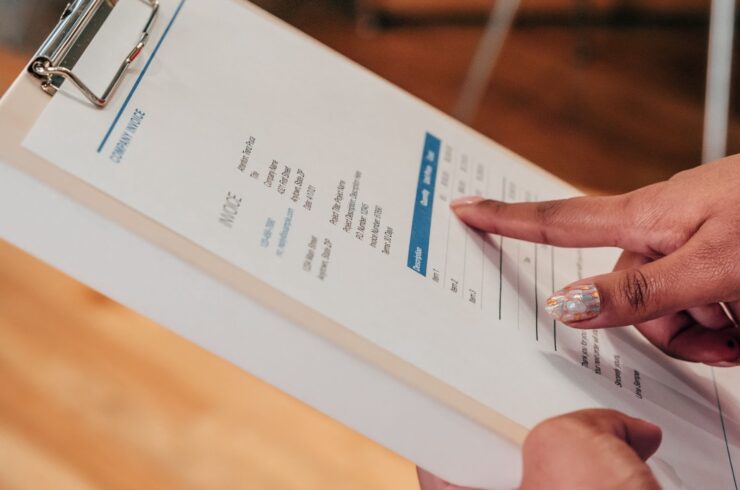Procure-to-pay: What Is It And What Are Its Benefits
For any business, procure-to-pay (P2P), the process of taking a product or service from procurement to payment, is an essential step in scaling.
In theory, it’s a simple enough concept. In practice, however, procure-to-pay can be quite complex. That’s because it often involves multiple departments and software systems within a company.
As a business grows, the complexity of product purchasing grows with it, and suddenly, as margins start to shrink because of procurement issues, an all-in-one solution is required.
If your business is struggling with this process right now, you’re in luck. Below, we’ll examine:
- What Is The Procure-To-Pay Process?
- What Are The Benefits Of Procure-To-Pay?
- What Procure-To-Pay Software Is Available?
- How To Choose A Procure-To-Pay Solution
- Challenges You May Face In The Procure-To-Pay Cycle
When you’re ready, let’s jump in!

6 Processes of Procure-To-Pay
The procure-to-pay process is the cycle of purchasing and paying for goods or services. It includes everything from identifying a need within the company to issuing payment to the supplier.
There are five main steps (plus an optional sixth) in the cycle.
1. Requisition
The first step in the procure-to-pay process is the requisition. This is when an employee (or group of employees) identifies a need for a product or service. A requisition can be generated manually or automatically through software that tracks company spending.
For example, if your sales team needs a new CRM system, they would create a requisition. This would outline the specific product or service they need, how much it will cost, and when they need it.
These requisitions should then be:
- Approved by a supervisor
- Added to the company’s budget
- Sent to the procurement department
Once it has been approved, we move on to the next step of the process.
2. Purchase Order
The second step is the purchase order (PO). This document is generated by the procurement department and sent to the supplier. It includes all of the information from the requisition, plus any additional details that have been negotiated with the supplier.
For example, if you’re purchasing a new CRM system, your PO would include how many licenses you’re buying, what type of support you need, and how long the contract will be for.
Once the supplier has received the PO, they will:
- Confirm that they can provide the product or service
- Agree to the terms and conditions outlined in the PO
- Ship the product or provide the service
Once everything has been confirmed and the product is on its way, you can move on to the next step.

3. Receiving
The third step is receiving. This is when the product or service arrives at your company and is checked for quality before adding it to your inventory. The receiving department will:
- Inspect the products or services
- Verify that the order is complete
- Ensure that the products or services meet quality standards
- If there are any issues with the order, they will be documented and sent back to the supplier.
Importantly, at this step, you should also update your accounting software with the new purchase (or have the automated solution do it for you). This will ensure that all of your financial records are up-to-date and accurate.
If everything is good to go, we move on to step four.
4. Invoice
The fourth step is invoice processing. This is when the supplier sends you an invoice for the products or services that have been delivered. The invoice will include:
- The total amount due
- The payment terms (e.g. net 30)
- Instructions on how to make the payment
At this point, you should check the invoice against your purchase order to ensure that everything matches up. If there are any discrepancies, you’ll need to contact the supplier and resolve them before you can move on.
Assuming everything looks good, you’ll need to approve the invoice for payment. This approval will likely happen in your accounting software. Once the invoice has been approved, you can move on to step five.

5. Payment
The fifth and final step is payment. This is when you send the money to the supplier. The payment will be processed according to the terms outlined in the invoice.
After the payment has been made, you’ll want to update your accounting software again. This end-to-end documentation of the procure-to-pay process is essential for keeping accurate financial records.
At this point, some would classify the procure-to-pay cycle as complete, though there is sometimes one more step included.
6. Track Performance
The final (optional) step in the procure-to-pay process is performance tracking. In this step, you’ll review how well the supplier performed and whether or not they met your expectations.
This information can be used to help you make future purchasing decisions. For example, if you were unhappy with the quality of a product, you might choose to purchase from a different supplier next time.
Performance tracking is often done through surveys or other feedback mechanisms.
Now that we’ve gone over the basics of the procure-to-pay process, let’s look at some of the benefits it can offer your business.
4 Benefits Of Procure-To-Pay
The benefits of procure-to-pay are many and varied but can be boiled down to two main points: cost savings and efficiency gains.
When done correctly, procure-to-pay can save your company money and resources in several ways. For example, by centralizing purchasing power, you can negotiate better prices with suppliers. And by automating the process with supply chain outsourcing, you can eliminate manual errors and speed up payment turnaround times.
In addition to cost savings, procure-to-pay can also lead to efficiency gains. For example, by automating the process, you can free up your employees’ time so they can focus on higher-level tasks. And by centralizing data, you can make it easier for decision-makers to access the information they need to make informed decisions.
Here are some other advantages of using a procure to pay system:
1. Streamlined Processes
Using a P2P system can streamline purchasing processes and reduce the time and resources required to complete a purchase order. Automation can eliminate manual data entry and reduce the potential for errors, allowing staff to focus on higher-value activities.
2. Cost Savings
P2P systems can help organizations to reduce costs by identifying opportunities to consolidate purchasing, negotiate better pricing with suppliers, and reduce the time and effort required to manage purchases.
3. Improved Compliance
P2P systems can help to ensure compliance with procurement policies and regulations. The use of standardized processes and automated approvals can help to reduce the risk of non-compliance and increase transparency.
4. Better Supplier Relationships
P2P systems can help to improve supplier relationships by providing greater visibility and transparency into the purchasing process. This can help to build trust and improve communication between buyers and suppliers.
Example Scenario
Let’s take a look at an example scenario:
You run a small business with 10 employees. Currently, when someone in your company needs to purchase a product or service, they send an email to the supplier with their request.
The supplier then sends an invoice to your accounts payable (AP) department. After the AP department verifies that the invoice is correct, they issue payment to the supplier.
This process wastes a lot of time and is prone to errors, and likely needs more resources than you have. For example, if an employee forgets to cc the AP department on their purchase request, the invoice may get lost in the shuffle. Or, if an AP department employee is out sick, payments may be delayed.
Now, let’s say you implement a procure-to-pay solution. With this solution in place, employees can submit purchase requests through a centralized system. The requests are then routed to the appropriate approvers — including the AP department — for approval.
Once approved, invoices are generated automatically and sent to the AP department for payment.

This process is more efficient and less prone to error. For example, because purchase requests are submitted through a centralized system, it’s easier to track them. And because invoices are generated automatically, there’s no risk of them getting lost in the shuffle.
In this example scenario, implementing a procure-to-pay solution leads to both cost savings and efficiency gains. But that’s not always the case. In some situations, the cost savings may not be significant enough to justify the investment. And in other cases, the efficiency gains may not be enough to offset the implementation costs.
What Procure-To-Pay Software Is Available?
Let’s look at a few available types of procure-to-pay software and how they can help.
Requisition Management Software
This software helps streamline the requisition process by giving employees a central place to create and track purchase requests. It can also automate the approval process so requisitions are approved more quickly.
Some standard features of requisition management software include:
- Creating and tracking purchase requests
- Approval workflow automation
- Integration with existing ERP solutions
- Customizable user roles and permissions
- Real-time data visibility into requisitions
These features help to reduce manual processes, improve accuracy, and streamline the procurement process.
Contract Management Software
Contract management software allows you to manage all your company’s contracts and documents in one place. With this type of software, you can keep track of which contracts are coming up for renewal, who is responsible for each contract, and what the terms of the contract are.
Here are some top features you’ll find in a contract management software:
- Centralized document storage
- Contract authoring and editing
- Approval workflow automation
- Real-time data visibility into contracts
- Integration with existing ERP solutions
When using it to manage your business procurement, you can easily keep track of all your company’s contracts and documents, streamline the review and approval process, ensure compliance with legal regulations, and reduce manual processes.
Spend Analysis Software
This gives you additional visibility into your company’s spending patterns. With this software, you can see where your company spends its money and identify areas where you can save.
- Reporting capabilities that allow you to track spending by suppliers and categories
- A dashboard that shows all of your company’s spend in one place
- Data analytics tools to help you identify areas for improvement or risk management
- Business intelligence capabilities that provide insights into how your company is spending its money
- Configurable spending threshold to help you monitor and control your company’s spending
When you integrate such a solution into your procure-to-pay process, you can maximize the efficiency and accuracy of your purchases while minimizing costs.
Supplier Management Software
Managing your relationships with suppliers is vital for any growing business. With this software, you can track supplier performance, manage supplier contracts, and find new suppliers.
- Payment request automation: You can automate supplier payment requests and ensure timely payments are made.
- Invoicing automation: Supplier management software can automatically generate invoices and ensure timely payments.
- Order management: With this software, you can easily manage purchase orders, ensuring all products are delivered on time.
- Contract management: Managing supplier contracts can be a tricky business. With this software, you will have an easy way to store and access your supplier contracts quickly.
- Integration with existing systems: A supplier management system can help you integrate your existing business resource planning software and make procurement easier.
- Supplier performance tracking: You can track supplier performance to ensure that they are meeting the requirements of your business. Especially with real-time performance tracking, you can quickly identify any issues and take action.
Procurement Management Software
This helps you streamline the procurement process. With this type of software, you can automate the Request for proposal (RFP) process, track supplier performance, and manage contracts.
- Automated purchasing processes: Here’s how an automated purchasing process works. When you’re ready to buy something, you enter the details into the software, and it will search for potential suppliers or vendors who can fulfill your order. You’ll then be able to compare prices, delivery times, and other factors before choosing a supplier.
- Centralized repository: Having a central repository for supplier information helps you keep track of your suppliers and the products they offer. This makes it easy to find what you need quickly and ensures that all the relevant data is stored in one place.
- Advanced analytics: Advanced analytics allow you to identify the best suppliers and prices for particular items. This can help you ensure that your budget is being used efficiently and give you a better understanding of how much money is spent on each item.
- Real-time tracking: With real-time tracking, any changes made by a supplier or vendor are reflected immediately in the system. This means that if there is a change in price or delivery time, you can adjust your budget and plans accordingly.
- Integration with other enterprise applications: By integrating procure-to-pay software with other enterprise applications, such as accounting and inventory management systems, all the data is kept up to date in one place. This makes it easy to access relevant information when needed.
The key for all of these software solutions is to find ones that provide an integrated end-to-end view of the procure-to-pay process. This will give you visibility into every stage of the process and help you to identify bottlenecks and areas for improvement.
How To Choose A Procure-To-Pay Solution
When it comes to choosing a procure-to-pay solution, there are a few factors you should consider.
Your Business Needs and Preferences
First, what type of business do you have? If you’re a small business with only a handful of employees, you might not need all the bells and whistles that come with enterprise software. Conversely, an enterprise solution is probably your best bet if you have hundreds or even thousands of employees across multiple locations.

Budget
Second, what’s your budget? Enterprise software can be expensive, so if you’re working with a limited budget, you may want to consider a smaller solution or even an Excel spreadsheet. Also, many advanced procurement solutions offer free basic services for a few users, then charge more for added features and larger user groups. On many occasions, you’ll find that you can get a lot of value for a relatively low cost.
Needed Features
Third, what features do you need? The procure-to-pay process can be simple or complex, depending on the size and needs of your business. Make sure the software you choose has all the features you need to streamline your process.
Typically, small businesses will require basic features, such as document management, invoicing, and payment processing. On the other hand, enterprises may need advanced features like analytics and automation.
Compatibility with Internal Ecosystem
Whatever solution you choose, ensure it’s compatible with your internal ecosystem. This includes your finance software, accounting system, and any other business systems you may use. An integrated procure-to-pay process will help streamline the purchase process and reduce errors.
If your chosen solution lacks compatibility, you may have to switch from one system to another or use a third-party connector. This can be time-consuming and costly.
Mobile Accessibility
Does the procure-to-pay solution offer mobile accessibility? In today’s world, it’s essential for businesses to have access to their data and processes from any location. Make sure the software you choose is compatible with both desktop and mobile devices.
Finally, take some time to read online reviews. Procure-to-pay software is a big investment, so you want to make sure you’re getting what you pay for.
Customer and Implementation Support
Make sure the software you choose has good customer support. You want to be able to get help quickly when you need it. Also, look for a provider that offers implementation services or at least provides helpful documentation so you can get up and running as quickly as possible.
Many software solutions also have extensive video resources, webinars, and other learning materials to help you get the most from your procure-to-pay solution.
Challenges You May Face In The Procure-To-Pay Cycle
The procure-to-pay process is not without its challenges.
Getting Started with the Software
The most common challenge is getting employees to use the software. For the software to be effective, employees need to be trained on how to use it and then actually use it.
Data Entry, Transfer, and Tracking
The more data you have, the more difficult it can be to keep track of everything. This is where a good software solution can help. A good solution will have features like data validation and import/export capabilities to make data entry easier.
Scalability
As your business grows, the procure-to-pay process can become more complex. This is why it’s important to choose a software solution that can grow with you. Look for features like workflow automation and supplier management to make the process easier as your business expands.
Handling Change Management
Sometimes there are issues with change management. Any time you implement a new system, there will be a period of adjustment as employees get used to the new software.
This is normal, but it can be disruptive to your business. To minimize the disruption, make sure you choose a software solution that is easy to use and has good customer support.
Integration with Other Platforms
Finally, you may also face challenges when it comes to integration. If you’re using multiple software systems, you need to make sure they all play nice together.
Otherwise, you could end up with duplicate data or other issues. A good procure-to-pay solution will have built-in integration features to make this process easier.
Here’s a handy checklist to work through when researching or analyzing a potential solution:
- Is the software easy to use?
- Is the software affordable?
- Does the software have all the features I need?
- Are there any integration challenges I should be aware of?
- What do online reviews say about the software?
If you can answer all of these questions, you should be well on your way to finding the right procure-to-pay solution for your business.

Final thoughts
In the current business climate of intense competition, having streamlined procurement processes is essential. Procure-to-pay software can help maximize efficiency and accuracy from requisition to payment.
Investing in the correct solution for your organization will increase productivity and cost savings while providing invaluable insights into procurement performance. Don’t delay – take your procurement strategy up a notch today!
